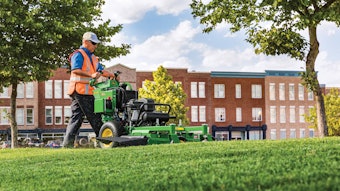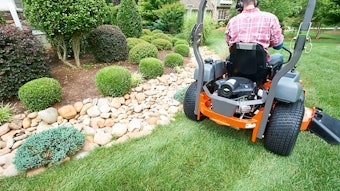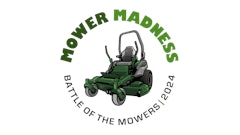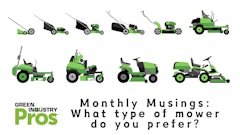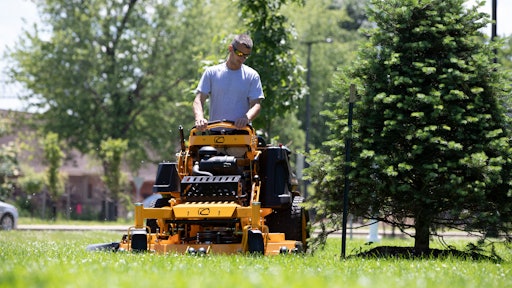
Most of the big-name manufacturers in the green industry offer a mix of stand-on and sit-down zero-turn (ZTR) mower models.
When they were first on the market in the early 2000s and only one or two models were available, it was understandable that the concept of a stand-on mower was not widely accepted. Until they tried it, landscapers were not aware of the advantages.
“Let's face it, we're creatures of habit and we stay with what we've done until we're forced to try something different a lot of times,” said Brad Unruh, Hustler Turf director of product strategy. “I think users have shunned it for long enough and now it's kind of like, well maybe there's something to this.”
The Wright Way
The original concept for the stand-on mower is usually credited to Wright Manufacturing. The idea of the Wright Stander was really the evolution from the Velke Sulky, a small trailer for users to ride behind a hydrostatic walk-behind mower.
“It was really driven by our need as a landscaping company to improve productivity and that was kind of the whole genesis of how it came to be,” Ed Wright, CEO of Wright Manufacturing said.
Over time, the unit evolved from standing on a little trailer to standing on the mower itself. In 1997, the company began production of the original Wright Stander and is not only a manufacturer.
Wright noted that the stand-on units began as small or medium-sized machines with lower ground speed.
As the category has grown, there has been more interest in the mid and larger-sized machines and more focus on comfort features such as upholstery on the pad and the platforms to stand on.
Today, the general use of the stand-on mowers is becoming more mainstream as manufacturers increasingly see a gradual shift within the commercial market to the stand-on units.
With Segways, hoverboards and standing desks, the idea of standing on something is not as foreign to the current generation. A lot of those same things that are kind of driving that stand-up workplace also carries through into why people would be interested in a stand-on mower.
“We see that trend come through where we're not wanting to sit in chairs all day and we're wanting to get up and be active and be able to be nimble and move and so the stand-ons really help people that are a little more apt to focus on that trend,” Ferris senior marketing manager Jennifer Walth said.
Wright agreed, adding that “Sitting has become the new occupational hazard.”
When seated, your spine is going into your tailbone all day long, and you're just constantly getting that that abuse.
“When you're standing up, the largest muscle in your body is your quads and your legs, so you're able to use the largest muscle in your body as a shock absorber when you're going over bumps in the properties,” said Aaron Griffith, national sales manager, professional business segment, Cub Cadet. “Our natural position is to stand up with our spine and bone structure in alignment and your blood flow is better so you're more alert throughout the day.”
Many landscapers report to their dealers and manufacturers that their crews are less fatigued at the end of the day from standing then sitting.
“Think about sitting in a in a in a recliner and watching TV, you're a lot more apt to fall asleep doing that than if you were standing up watching TV,” UnRuh said. Similarly, he suggested that sitting down on a mower for most of the day, an operator could get into that comfort zone versus standing, where they tend to be more alert and aware of what’s going on while moving their body around.
“When you're standing the give is all in your in your knees and your legs,” Unruh noted. “Whereas if you're sitting and even if you have suspension in that seat, it's still your whole body and your back that's jarring when you hit uneven ground.”
On a ZTR, users tend to get jostled a lot, leaving them hunched over and often not leaning into the seat. Doing that for a large amount of time is not comfortable.
Wright noted that on a commercial property oftentimes, there is a whole variety of things that happens on a job site.
“We found that the mower isn't used for more than about 10 minutes at a time because you may have to stop and pick up debris or open a gate or something like that,” he said. “When you are sitting on a mower, you have to climb down and climb back up to 75 to 100 times a day. There is a certain amount of fatigue with that rhythm, whereas a stand-on mower is much more efficient and, also much more ergonomic to not have to climb off the machine every time you do another 10.”
It's All About Production
Some hesitation for landscapers is the general perception of the stand-on units.
"For landscapers, time is money, and if they can save a couple of minutes of property here and there that can really add up time,” Griffith said. “At the end of the week, at the end of the day, at the end of the month, to either go out and get more business or to make their properties look even better it really has a lot to do with productivity.”
Griffith said for those landscapers doing a lot of residential properties, not only is a stand-on going to be more productive but a big 60-inch sit-down zero-turn mower can be a little intimidating to go on a residential property.
“You take a 52-, 54 or 60-inch stand-on machine and while it's the same size of machine cut wise, it doesn't look quite as imposing whenever it goes out on the onto a property,” he said.
Hustler Turf’s Super 88 debuted at the 2019 GIE+EXPO. The unit features a 54-inch deck with two pivoting wings, which fold for transport, that give it a full 88-inch cut.
“You're just making the commercial guy a lot more productive standing rather than sitting so again a kind of a unique concept and we're starting to see a lot of success even with just introducing it back in October,” Unruh said.
Ferris offers the SRS Z1, SRS Z2 and SRS Z3X stand-on mowers ranging 36-, 48-, 52-, 61- and 72-inch decks.
“What we learned is they want the biggest they can that doesn't overpower their properties,” Walth said. “Bigger doesn't always become better. They're looking for something that is versatile, that will fit as many properties as possible.”
She said the 52-inch models seems to be the sweet spot. Similarly, Griffith said the 54-inch deck size on the Cub Cadet Pro X stand-on mowers appears to be the most popular. Those machines have the option for 48-, 54- or 60-inch decks.
“Before we even built one unit we went across the country and met with more than 50 landscapers and talked to them about what they liked about the machine they currently had and what they didn't like,” he said. “What we tried to focus in on with the stand-on mower is take the feedback we got from all of those pain points that landscapers felt with the current brands that they were using, and tried to address them.”
Safety Steps
No matter the model, there is always going to be hazards with larger equipment. With a stand-on mower there are a few hazards that are reduced compared to a ZTR.
Wright suggested the learning curve between a stand-on mower and a ZTR is about the same.
“From a commercial standpoint, there's always going to be a learning curve on the equipment, but oftentimes, the thing what's more important is how productive and safe can somebody be in the long haul,” he said. “On a stand on mower, you're not trapped on the machine and it's a lot more versatile. The benefits are there to get over a little bit of training curve.”
On a ZTR, the operator is stuck in the seat.
“When you're on a stand-on, you've got a little bit more freedom of mobility, so you can lean, just like you would if you're on a motorcycle or on a set of skis on a slope, you can lean on the high side of that slope, to not necessarily give you that much more stability but it's more to make you more comfortable when you're on the slope,” Griffith said.
For example, Wright said if a landscaper is mowing on a slope and the machine begins to slide down the hill or go off a ledge, they can exit off the back and step off rather than being strapped on the front of the machine.
“It means that if there's a there's an accident like that, oftentimes the impact of that accident is significantly reduced,” he said. “There's definitely some advantages from a safety standpoint, with stand-on mowers.”
From an operator standpoint, visibility to the turf is much better when standing versus sitting.
“Think about anything that might be in that yard that now you have visibility of so you won't mow over it or realize that you just hit it and broke a blade or shot some object out,” Unruh said.
In addition to being able to see the obstacles, a stand-on mower making it easier to get off and move those items as well.
“On a stand-on, it’s very easy to just jump off, go grab that stick or that hose and move it out of the way and jump back on and keep mowing,” Unruh said.
On a traditional sit-down zero-turn mower, operators have to pull the levers back, unbuckle a seatbelt, get up out of the seat, pick up the debris or trash and then reverse that whole process over again to resume mowing.
With a stand-on mowers, nearly all the steps are eliminated as the operator shuts off the blades and sets the parking brake and then easily steps off and back on to resume mowing. That bailout option saves about three seconds each time the operator gets off the machine versus a zero-turn. Those three seconds can add up to a lot of time across multiple properties, possibly even enough to add another property into the day.
“If you've ever tried it, you'll quickly understand the advantages to the stand-on unit and how very easy it is to get on and off,” Unruh said.
Standing in the Future
At the end of the day, it comes down to personal preference.
“I've talked to guys that said they've tried a stand-on mower and they just didn't feel as comfortable,” Unruh said. “I think if you're coming new into the commercial landscaping market, I think it would be wise to try them both.”
Griffith suggested that industry newcomers are more apt to look at stand-on mowers then some veteran landscapers because of having that outside viewpoint of the current trends.
“For a startup landscaper, it's a more versatile machine,” Griffith said. “It kind of gives you the best of both worlds where you get the maneuverability of a walk behind with the speed of a sit down zero-turn. You are going to have a lot more versatile package with the stand-on than you are those other two models that are predominant in the landscape space. “
Part of the interest in a stand-on mower is based on the looking at it from the standpoint of a cost structure for a landscape company and management of capital investment in equipment.
The stand-on mowers and traditional zero turns are generally comparable from a price perspective. In most cases, all the same components are present with a little less steel in the chassis on the stand-on units.
“We're all trying to make sure our dollar goes the longest possible,” Griffin said. “When you look at a 60-inch zero turn retailing well over $10,000 typically, for a commercial unit, a stand-on unit is going to be, for example $9,499.”
Most landscapers are replacing equipment every two to three years. As more have tried out the stand-on machines, more of those units are becoming available in the used market, which allows some of the newcomers to the industry to try one out without a huge financial commitment.
The important thing as a landscaper is to really understand the properties and what is going to work for those properties.
“If you're a landscaper, and you're doing all residential and maybe some small commercial properties I think you could go easily 100% stand-on and you've seen companies that have done that,” Griffith said.
Conversely, a landscaper that is mowing larger commercial properties and some small properties may be best suited to carry a mix of stand-on and sit-down zero-turn mowers.
Walth said she has seen everything from commercial landscapers that run only ZTRs, some that have mixed fleets and some that are all stand-ons. “It just depends upon the business and what's important to the operator,” she said.
The manufacturers agreed that depending on the intended application, both styles of mower will be seen on trailers in coming years. Also, stand-on mowers take up less space on the trailer or in the landscaper's shop.
“Stand-on mowers are typically a little more compact than a than a sit down unit and that makes it a little easier to get in and out of some tight spaces, such as narrow backyard fences,” Unruh said. “I think there's advantages to both and I think they both have a place in the market.”
With technology continuing to advance, it is clear the mower market will continue evolving.
“I think you're going to continue to get people to switch and move to stand-on machines but I think there's going to be a balance for both of them out there for quite some time,” Unruh said.



